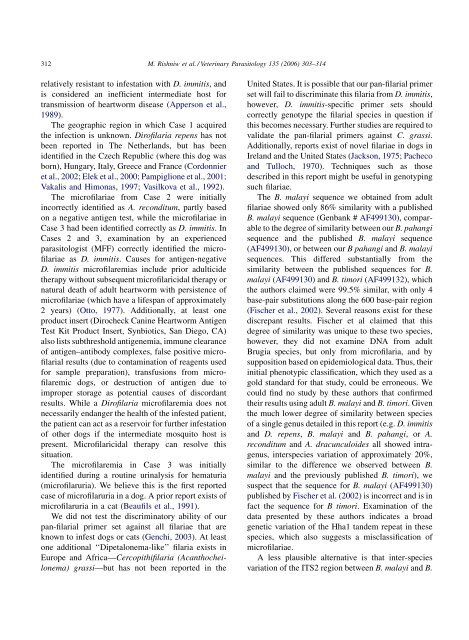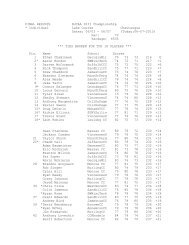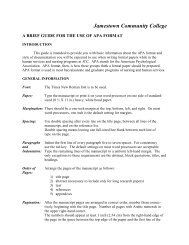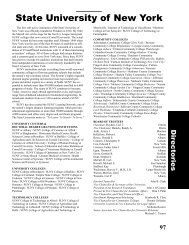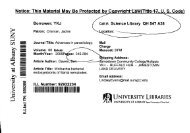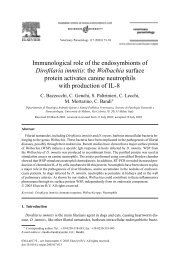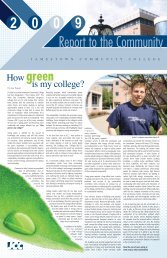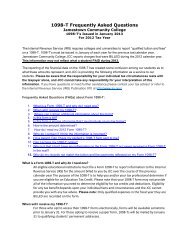Discrimination between six species of canine microfilariae by a ...
Discrimination between six species of canine microfilariae by a ...
Discrimination between six species of canine microfilariae by a ...
You also want an ePaper? Increase the reach of your titles
YUMPU automatically turns print PDFs into web optimized ePapers that Google loves.
312<br />
relatively resistant to infestation with D. immitis, and<br />
is considered an inefficient intermediate host for<br />
transmission <strong>of</strong> heartworm disease (Apperson et al.,<br />
1989).<br />
The geographic region in which Case 1 acquired<br />
the infection is unknown. Dir<strong>of</strong>ilaria repens has not<br />
been reported in The Netherlands, but has been<br />
identified in the Czech Republic (where this dog was<br />
born), Hungary, Italy, Greece and France (Cordonnier<br />
et al., 2002; Elek et al., 2000; Pampiglione et al., 2001;<br />
Vakalis and Himonas, 1997; Vasilkova et al., 1992).<br />
The micr<strong>of</strong>ilariae from Case 2 were initially<br />
incorrectly identified as A. reconditum, partly based<br />
on a negative antigen test, while the micr<strong>of</strong>ilariae in<br />
Case 3 had been identified correctly as D. immitis. In<br />
Cases 2 and 3, examination <strong>by</strong> an experienced<br />
parasitologist (MFF) correctly identified the micr<strong>of</strong>ilariae<br />
as D. immitis. Causes for antigen-negative<br />
D. immitis micr<strong>of</strong>ilaremias include prior adulticide<br />
therapy without subsequent micr<strong>of</strong>ilaricidal therapy or<br />
natural death <strong>of</strong> adult heartworm with persistence <strong>of</strong><br />
micr<strong>of</strong>ilariae (which have a lifespan <strong>of</strong> approximately<br />
2 years) (Otto, 1977). Additionally, at least one<br />
product insert (Dirocheck Canine Heartworm Antigen<br />
Test Kit Product Insert, Synbiotics, San Diego, CA)<br />
also lists subthreshold antigenemia, immune clearance<br />
<strong>of</strong> antigen–antibody complexes, false positive micr<strong>of</strong>ilarial<br />
results (due to contamination <strong>of</strong> reagents used<br />
for sample preparation), transfusions from micr<strong>of</strong>ilaremic<br />
dogs, or destruction <strong>of</strong> antigen due to<br />
improper storage as potential causes <strong>of</strong> discordant<br />
results. While a Dir<strong>of</strong>ilaria micr<strong>of</strong>ilaremia does not<br />
necessarily endanger the health <strong>of</strong> the infested patient,<br />
the patient can act as a reservoir for further infestation<br />
<strong>of</strong> other dogs if the intermediate mosquito host is<br />
present. Micr<strong>of</strong>ilaricidal therapy can resolve this<br />
situation.<br />
The micr<strong>of</strong>ilaremia in Case 3 was initially<br />
identified during a routine urinalysis for hematuria<br />
(micr<strong>of</strong>ilaruria). We believe this is the first reported<br />
case <strong>of</strong> micr<strong>of</strong>ilaruria in a dog. A prior report exists <strong>of</strong><br />
micr<strong>of</strong>ilaruria in a cat (Beaufils et al., 1991).<br />
We did not test the discriminatory ability <strong>of</strong> our<br />
pan-filarial primer set against all filariae that are<br />
known to infest dogs or cats (Genchi, 2003). At least<br />
one additional ‘‘Dipetalonema-like’’ filaria exists in<br />
Europe and Africa—Cercopithifilaria (Acanthocheilonema)<br />
grassi—but has not been reported in the<br />
M. Rishniw et al. / Veterinary Parasitology 135 (2006) 303–314<br />
United States. It is possible that our pan-filarial primer<br />
set will fail to discriminate this filaria from D. immitis,<br />
however, D. immitis-specific primer sets should<br />
correctly genotype the filarial <strong>species</strong> in question if<br />
this becomes necessary. Further studies are required to<br />
validate the pan-filarial primers against C. grassi.<br />
Additionally, reports exist <strong>of</strong> novel filariae in dogs in<br />
Ireland and the United States (Jackson, 1975; Pacheco<br />
and Tulloch, 1970). Techniques such as those<br />
described in this report might be useful in genotyping<br />
such filariae.<br />
The B. malayi sequence we obtained from adult<br />
filariae showed only 86% similarity with a published<br />
B. malayi sequence (Genbank # AF499130), comparable<br />
to the degree <strong>of</strong> similarity <strong>between</strong> our B. pahangi<br />
sequence and the published B. malayi sequence<br />
(AF499130), or <strong>between</strong> our B pahangi and B. malayi<br />
sequences. This differed substantially from the<br />
similarity <strong>between</strong> the published sequences for B.<br />
malayi (AF499130) and B. timori (AF499132), which<br />
the authors claimed were 99.5% similar, with only 4<br />
base-pair substitutions along the 600 base-pair region<br />
(Fischer et al., 2002). Several reasons exist for these<br />
discrepant results. Fischer et al claimed that this<br />
degree <strong>of</strong> similarity was unique to these two <strong>species</strong>,<br />
however, they did not examine DNA from adult<br />
Brugia <strong>species</strong>, but only from micr<strong>of</strong>ilaria, and <strong>by</strong><br />
supposition based on epidemiological data. Thus, their<br />
initial phenotypic classification, which they used as a<br />
gold standard for that study, could be erroneous. We<br />
could find no study <strong>by</strong> these authors that confirmed<br />
their results using adult B. malayi and B. timori. Given<br />
the much lower degree <strong>of</strong> similarity <strong>between</strong> <strong>species</strong><br />
<strong>of</strong> a single genus detailed in this report (e.g. D. immitis<br />
and D. repens, B. malayi and B. pahangi, or A.<br />
reconditum and A. dracunculoides all showed intragenus,<br />
inter<strong>species</strong> variation <strong>of</strong> approximately 20%,<br />
similar to the difference we observed <strong>between</strong> B.<br />
malayi and the previously published B. timori), we<br />
suspect that the sequence for B. malayi (AF499130)<br />
published <strong>by</strong> Fischer et al. (2002) is incorrect and is in<br />
fact the sequence for B timori. Examination <strong>of</strong> the<br />
data presented <strong>by</strong> these authors indicates a broad<br />
genetic variation <strong>of</strong> the Hha1 tandem repeat in these<br />
<strong>species</strong>, which also suggests a misclassification <strong>of</strong><br />
micr<strong>of</strong>ilariae.<br />
A less plausible alternative is that inter-<strong>species</strong><br />
variation <strong>of</strong> the ITS2 region <strong>between</strong> B. malayi and B.


